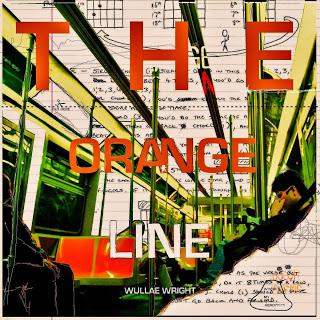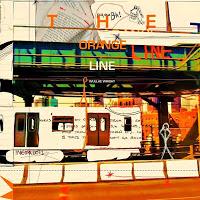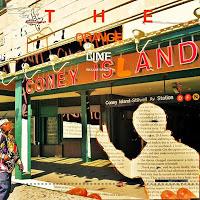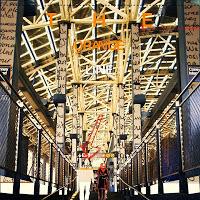
Myth. Enthralling and eclectic stories unfold and cast a spell on their audience. Swift and surprising events pass by, vague details gleam, concrete and form a ponderous and defining narrative frame. Tension grows, is strained and temporary resolved, only to be picked up once more, this time though to last until the very end. The aftermath is stirring, evocative and most likely satisfies.
After all, it's a wandering. A winding road, an elusive and audacious journey for those who are willing to embark. To embark at the risk to go astray every now and then, knowing though it's what makes for a thrilling and exciting experience, a memorable, a worthwhile one. It's those unexpected turns, those deep and irritating yet enriching moments of uncertainty that eventually lead to what made the curious initially pursue this rough and obscure road: the urge for clarity, the thrill of excitement and the boundless passion to explore.
The tales sung and whispered are ancient and adventurous, mysterious at heart. Still, they are progressing and aligned, determined and to a certain exceed predictable, familiar sounding ones. Theseus, Ariadne and the Minotaur. Paws within the realm and prevalence of the olympian gods. Characters of the greek myth. It's a myth well-known, an exciting and epic one. As the eventual Athenian king was determined to end the Creatan Minotaur's life in order to also end the nefarious sacrifice of seven boys and seven maidens every nine years, Theseus met Ariadne, the Creatan princess, who helped him escape the maze the ferocious monster lived in. She furnished Theseus with a clew of thread for him to roll out, so he could find the labyrinth's excit after murdering the Minotaur. It has been this very thread thatguided him after not only facing adversities, but also after successfully facing the monster, after going astray. This very thread helped the future king to exit the maze, being richer in experience, more mature and firm in respect to his destiny and destination.
Album cover (gain an insight into 'The Orange Line' booklet
at Wullae Wright's website)
Don't get me wrong: listening to Wullae Wright's latest full-length release will probably not make as a defining, thorough impact on the audience's life as the thread did for Theseus depicted in the classic myth above, 'The Orange Line' (2013) will though - and that's easy, certain to spot and predict - leave marks in the listeners' music routine, will make them appreciate complexity, growthand subtlety on a deeper level.
However, in order to connect to the stories told within Wullae's songs, to entirely open up to the musical journey that lies ahead, you need to lose yourself in the sound of the music. Let go. Then, after a while embrace the compositional constant, the familiarly resounding chimes, the acquainted timbre that makes you emerge in clarity and delight. Escape the musical maze, the mellifluous but excitable instrumental and vocal layers, the mesmerizing and discomposing yet cunningly composed songs presented on 'The Orange Line'. Be guided by a tonal, by an audible line that leads securely through the 13 tracks, allows indulgence and mental deviation though. By saying tracks, it's meant in the true sense of the word, as these compositions gonna leave a lasting and acute imprint and impression on you, grant diverse approaches and perception. Grant eventually both refuge in and escape out of the hypnotising, vast and hardly tangible acoustic shaded, indie rock anthems the british singer/songwriter showcases.

British artist/singer/sonwriter
Wullae Wright
A grand and memorable debut for 'The Orange Line' is given with the 8:22 minutes lasting first track of the album, which is not only the longest, but also the most multi-layered, varying and progressive song of the record. 'UFO' is introduced with a calmly, harmoniously fluent instrumentation, ambient and mellow violin melodies sound, and the listener is drawn into a placid tonal setting. But not for long - scratchy and fuzzy guitar riffs, sharp and incisive vocals carve in, rousing drum beats echo, and the listener is abruptly carried away, wanders through a rather unstable, upsetting and sonorous tonal landscape. A sudden melodic transition occurs: an acoustic guitar resonates gently, in an ethereal manner, whimsical, emotional vocals cry out and back the minimalist lyrics of the song 'You cry out, you cry out' - an overal melancholic, gloomy atmosphere is created and soon impelled further. Swift, eccentric changes in instrumental and vocal sonority determine the listener's musical journey, at times orotund and dynamic, at times smooth and calm, only interrupted by a dreamy interlude that enchants with a sentimental, soft string section arrangement, laid-back guitar sound and sensitive, faint but nonetheless poignant vocals. It's about letting go and being captured by the sound time after time, being segued from one instrumental section to another. The song evolves and expands, floats melodically, not without conspicuous erratic and extreme tonal and vocal alternation though, rises up once more by implementing excessive instrumental fragments. Raspy guitar riffs, accentuated and vehement drum beats resound, followed by a final, thrilling musical shift: whilst light acoustic guitar melodies mingle with a gentle bass line, elctronic guitar shades invade the rather quaint instrumentation and fade out into a harmonious and ambient violin closure. 'UFO' thereby shows slight coherency, still surprises the audience with a vivacious, growing compositonal concept which brisks up, gives direction though by presenting a strongly outlined, rapid vocal performance.
An evolving conception underlines 'A Stage with your own Fears' too, as dominant, pungent vocals, drastic in sound, gain vigor and solid vibrancy throughout the track and are backed by an enigmatic, audacious instrumentation. Whilst emphatic and atmospheric cymbal sound, brisk drum beats stirr, it's the tonal fade-out of the song though that deeply impresses: it's an agitative and intense coalescence of string section and electronic layers that gets under the listener's skin.
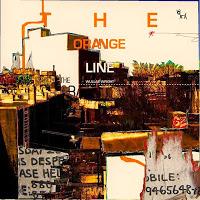
Album artwork I
'Roadtrippin' makes for a vertiginous ride: feisty and repetitive guitar riffs initially evoke a persistent and melodic sound, that is strongly shaken by a clangorous, rasping and fierce vocal performance. A vocal performance that is bizarre but expressive, that rises to be a rough and fervent torrent bursting out. A vocal performance that is then enriched by more reverberative guitar riffs, severe and powerful drum beats as well as by tenuous, electronically generated chimes of bells which create an impetuous, thrilling atmosphere.The audience, the imaginary wanderer embraces a tender and tranquil composition whilst indulging in 'Nostalgic'. Rasp, evocative vocals with smooth resonance blend well with the mellow, delusive acoustic guitar melodies, alternate with emphatic and empathic vocal murmur. And there's indeed a nostalgic feel induced when piteous and ardent, almost yearning vocals fantasize about escapism: 'Nostalgic, running away to another world for another day'.
Album artwork II
The musical journey continues and heralds in the next composition: 'Stand Alone' unfolds with an elated instrumental intro that focuses on avid but gentle guitar melodies and bright cymbal sound, that features characteristic, reverberative and daring vocals, vocals which define the entire song and approach the rather melancholic lyrics. Extreme and mutinous guitar riffs temporarily prevail as a tumultuous and thrilling guitar solo sets in by which Stuart Carroll shows off his skills impressively. The arrangement concretes, grows stronger and leads to an ingratiating, disharmonic but infectious confluence of rhythmic drum beats and vivid, melodic guitar sound. A grand burst of instrumental density then finds its unexpected closureas Wullae's voice roughly echoes: 'Tell me, tell me your story'.'Survived Unpromised Souls' depends on its storytelling nature, the lyrics are perceptive, affectionate and reach out to the listener's soul and mind, draw him into the lyrical narration, the musical voyage through 'bruised', sensitive vocals, which are accompanied by placid guitar melodies. It's an unhasty and smoothly purling tonal stream, whereas the lyrics are accentuated, strike vigorously due to the vocals' firm and pervading timbre.
The listener feels emotionally involved, affected by the expressive and sentimental vocals that set in with the first notes of 'You Never Said Anything'. The resentful undertone within the vocals is hard to ignore and when clangorous cymbals sporadically irrupt the rather apollonian, harmonious instrumentation, the listener finds himself eagerly awaiting an audacious vocal eruption. As if by command, the instrumental arrangement gains speed, gains depth, remains swift and dynamic though, while the vocals attain a more trenchant sonority.
'Living On The Edge' marks a musical crossroad on the album: the songs start to be more experimental, even more bold, insistent in sound. The eighth track of 'The Orange Line' comes in with an elusive and languorous instrumental intro, it's an intense one, both tonally and emotionally intense. The initial, atmospheric melody is soon enhanced by dim guitar riffs, poignant and grave vocal harmonies. Clangorous cymbals eventually announce dark polyphonic vocal interludes by which the composition completely reveals itsmysterious, obscure character.
Album artwork III
The artifical music concept 'Plasticland' embodies, blends well with its honest and arousing lyrics. A refreshing and distinctive bass line merges with sweeping and blurry guitar riffs, and is only excelled in its melodic deviation by whispering, ambient but sharp vocals with bluesy timbre.The sound of a symphonious and dreamy string section, of melodious guitar riffs imbues the air at the very moment at which 'Superhero' begins to resonate. A blissful, soothing listening atmosphere is established, intensified though by a soul-stirring and moving vocal performance which has an absorbing effect on the listener as the vocals alternate between fragile and haunting, severe sound.
It's the adventurous, experimental root of 'Beware: Beckon Angels' that takes the listener captive, that increasingly involves him, makes him delve into its rapid and venturous instrumental structures. Impetuous changes in pace, energetic and gripping guitar riffs as well as perky, inconsistent drum beats and raucous, passionate vocalsdistinctive of a grungy, individual timbre bring forth musical tension that is staggering and intriguing.
'A Story Of A Wall' is manifested as an irregular and salient tonal experience: disturbing, stirring brazen sound roars, is outdone though by bluesy and deep vocals of edgy tone quality which are backed by atmospheric guitar melodies. Audible, concrete suspense isdeveloped and resolved after a short but tense musical break: gloomy, eager silence ends in a repetitive yet keen instrumentation with no drastic change.
Dulcet and dreamful melodies strike a rather ambient and sensitive tone once more: 'All The Time' stimulates with emotive vocals which feature a warm, soulful timbre, the song mesmerizes with melodic and serene bass as well as with harmonic and lucid guitar sound. The haunting and euphonious sonority of the illustrious violin and the now stormy, eccentric vocals escalates as fuzzy guitar riffs and vibrant drum beats fit in, as they eventually cause an intent, a firm but poignant overall sound. 'All The Time' is a worthy and memorable finish for 'The Orange Line' - one that pictures the ambivalent, nebulous and subtle essence of each song presented on the album.
As eclectic, as offbeat, as dazzling the compositional and tonal conception of the 13 songs might be, might appear after the first listen, the permanent emphatically, incisively resonating, evocative vocals stand out against the edgy instrumentation, shine brightly and thereby not only loom but also prove to be the album's constant, the guiding line, the tonal thread of orientation that allows a thorough and expansive journey through the melodic, lyrical and vocal depth of 'The Orange Line' yet also ensures mental, emotional distanglement, escape from the mesmerizing musical maze Wullae Wright has arranged.
Yet it's not only the music that overwhelms, it's not only the sound you find yourself amazed by. It's the album's concept in its complexity that guarantees both a rewarding listening experience and a spectacular visionary journey. Wullae Wright distinguishes himself as an accomplished, exceptional singer/songwriter but also as a poet, as an artist. His lyrics may be minimalist, repetitive at times but they are scenic, trenchant ones. His album artwork is singular, hard to compare. It's rich in details, shows fascinating architectural structures and eidetic, charming drafts.
Album artwork IV
Album artwork V
Thus 'labelling' Wullae Wright as a 'musician' would do him no justice, he's an inspired and inspiring artist (read also about this aspect and raiting here). One that hypnotizes with his compositions, one that takes the listener on a journey with his songs, one that leaves a lasting impression on his audience and one that encourages to indulge in his music - once, twice, once more.
You can find out more about Wullae Wright on his website as well as on 'house in the sand', you can reach out to him on facebook (give him a 'like') and twitter (follow this exceptional artist). Introduce yourself, embark on his music and enjoy a singular listening experience!
